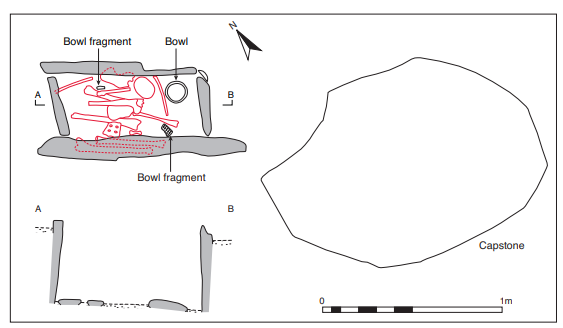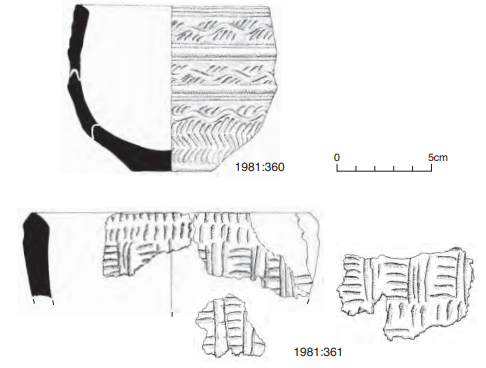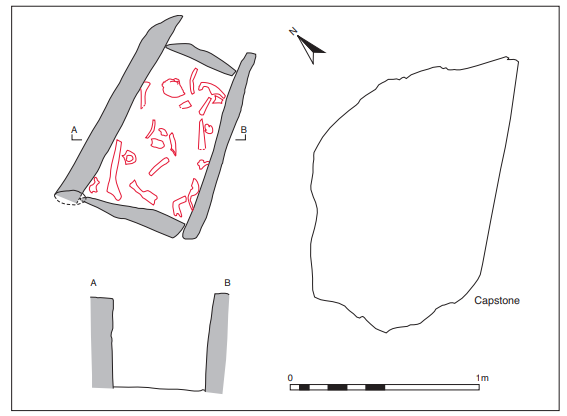County: Kildare Site name: TIMOLIN, CO. KILDARE
Sites and Monuments Record No.: SMR KD036-036 SMR KD036-037SMR KD036-027002SMR KD036-047 Licence number: E1091
Author: RAGHNALL Ó FLOINN AND NESSA OCONNOR
Site type: Early Bronze Age graves
Period/Dating: —
ITM: E 679733m, N 693785m
Latitude, Longitude (decimal degrees): 52.988863, -6.812454
Introduction
In November 1981 a short cist containing an inhumation and two vessels was discovered during ploughing near Ballitore, Co. Kildare. The field in which the cist was found had first been ploughed four years previously. The find was reported to the NMI by Mr Martin Kelly of Celbridge, and a rescue excavation was undertaken by Raghnall Ó Floinn. The human remains from the cist were examined by Professor C.A. Erskine. A second cist was discovered in 1982 and was excavated by Nessa O’Connor.
Location (Fig. 3.82)
The site was in the townland of Timolin, south-east Co. Kildare, close to the border with County Wicklow.132 It was situated above a break in slope to the north-west in a field known


as the ‘Rampart Field’ at an altitude of 90–100m above sea level. The cist (grave 1) lay to the west of the River Greese, just 0.5km north-west of Timolin village. The capstone of a second cist (grave 2) lay some 10m to the east. This was excavated in 1982.133 A third cist is marked on the SMR in the same field as grave 2, just a few metres south of it.134 In 1999 two cists and two pit burials under a mound were excavated c. 20m north-east of grave 1 (Breen 2000,135 137–8).. Another possible association is evident in Museum correspondence from 1948, when four skeletons and ‘a large flag’ were unearthed at Timolin.136
Grave 1
The cist was roughly rectangular in plan, with its long axis aligned north-west/south-east. Internally it measured 0.75m long by 0.35m wide by 0.44m high (Fig. 3.83). It was composed of four rectangular slabs set on edge, one forming each wall. The northern side stone was inclined sharply inwards, probably as a result of being struck by the plough as the other side stones were almost vertical. The southern side slab was the largest and extended beyond each end of the cist. It measured 1.16m long by 0.11m thick. There was no evidence for packing stones around the outside of the cist. The chamber was sealed by a large, suboval capstone measuring 1.6m long by 1.15m wide. The floor of the cist was roughly paved with four flat stones, which did not cover the entire floor area.
The cist contained the unburnt disarticulated remains of an adult male (1981:342), a complete tripartite bowl and sherds of a bipartite bowl. The upper fill of the cist contained many loose bones, largely vertebrae and rib bones. It was clear from the gaps between the more compactly packed bones underneath that there was little or no soil in the cist before its discovery. On removal of the loose bones an area of more tightly packed bones was encountered. This consisted of most of the long bones and the pelvic bones. The former were packed with their long axes parallel to that of the cist. Between and under these were found pieces of the fragmentary vessel. This had clearly been broken in antiquity, as a deposit of calcium covered the edges of some of the sherds. The skull was also deposited in three fragments and indicates that no great care was used in depositing the bones and the vessels. According to the finder, the bowl was found mouth upwards in the north-eastern corner of the cist. It would therefore have been placed near the skull. The two largest sherds of the second vessel, two rim sherds, were found in the same half of the cist but near the northern side stone. Some gravel was found within the cist, and this had presumably spilled in through the spaces between the side stones.
Tripartite bowl, 1981:360 (Fig. 3.84)
The vessel is a tripartite bowl as classified by Ó Ríordáin and Waddell (1993). It was apparently intact when found but several sherds are now missing. Much of the exterior and part of the interior is covered with limescale. The core is dark black with brown surfaces. Traces of charcoal or soot are visible on the inner surface. Mica flecks are also visible on the surface
The vessel is of tripartite form with internal rim bevel. Each segment is decorated with a running chevron against a diagonally hatched ground, bordered by two or more incised lines. The lower segment is further decorated with a herringbone design. The vessel appears to be coil- or ring-built and has fractured along the joins of the coils.
Dimensions: H 8.5–9cm; D rim 10–10.5cm; D base 4.5cm.
Bipartite bowl, 1981:361 (Fig. 3.84)
Sherds of a bowl survive, apparently all of the upper half, possibly of bipartite form as classified by Ó Ríordáin and Waddell (1993). The rim is bevelled internally. There are two slightly raised cordons below the rim and another two further down the body. The areas between the two cordons are decorated with closely spaced vertical incised lines, as is the area between the central cordons. The space between the cordons is decorated with ladder patterns. The vessel is of coarse fabric with large (up to 5mm) angular quartz grits. The core is black with brown surfaces. Two rim sherds are covered with a limescale, visible in fractures, indicating that the vessel had been broken in antiquity.
Dimensions: est. D rim: 16cm.


Grave 2
The cist was trapezoidal in plan, with its long axis aligned north-east/south-west. It measured 0.88m long by 0.55m wide by 0.46m high internally (Fig. 3.85). Four edge-set slabs defined the chamber, with one forming each wall. The maximum dimensions of the slabs are 1.15m long by 0.48m high by 0.13m thick. The end stones extended beyond each side of the cist at the eastern end. Only one packing stone was noticed on top of the south-west corner of the cist. This may have served to level the cist walls. The floor of the cist does not seem to have been paved. A large, suboval capstone, 1.58m long by 1.09m wide, sealed the cist.
The cist contained an inhumation burial (1981:121) and no accompanying artefacts were found. From the plan it would appear that the bone was either disarticulated or disturbed after discovery. The human remains were not analysed.
Comment
The radiocarbon date of 3700±30 BP137 was produced from collagen from grave 1 and is calibrated to 2200–1980 BC at 95.4% probability. Brindley (2007, 246–7) places the bowls from grave 1 in stage 2 of the development of the bowl tradition and suggests that the pottery of this stage can be dated to a period of about 100 years centring on 2030 BC. The site excavated in 1999 (99E0203138) was a low mound, in which two pits and two cists were located in the portion excavated. One cist produced an upright vase and an undecorated inverted vessel, suggesting a later date for this burial and perhaps indicating a continuation of burial practice in the area. There was also a quantity of cremated bone representing two adults and one child. The other cist produced a crouched inhumation of a young woman but no gravegoods, while the pits produced varying amounts of cremated bone.
HUMAN REMAINS
C.A. ERSKINE
The collection (1981:342) comprises the skeleton of one adult male, height 170–172cm; age 25–30 years; fairly complete; ribs, hand and facial bones complete and fragmentary
Skull: eight pieces: occipital, parietal, two temporal well preserved; sutures not fused; Wormian bone at lambda; fragment only of greater wing of sphenoid of left side. Mandible incomplete, posterior half of right side, part of ramus and body; unerupted part of third molar and premolar present.
Vertebral column: fourteen vertebrae, some well preserved. Fifth lumbar shows sacralisation, asymmetric, articulating on left side.
Rib fragments: 5–15cm, none complete. Manubrium present.
Sacrum: three segments of upper part only present.
Iliac bones: one large fragment of each. Upper limb: two humeri, right complete, left head
missing; both bones well marked.
Radius and ulna of left side complete; only upper half of right side. Fragment of right scapula: head and coracoid process. Lateral half of left clavicle. Hand: only two phalanges and one metacarpal, one carpal (hamate).
Lower limb: two complete femora: right in two fragments, post-mortem break in shaft; partial post-mortem break in left. Tibiae: complete. Fibulae: both complete, left post-mortem break. Right and left patellae present.
Foot bones: fairly complete. Right and left calcanei, talus, navicular, left cuboid, left medial and lateral cuneiform; metatarsals present except for second and third of right side. Only one phalanx present.
REPORT ON PETROLOGY OF BOWLS 1981:360 AND 1981:361
J.S. JACKSON
Angular quartz grains and pebbles abundant in large sherd. In the small fragments (also 1981:361) quartz pebbles are very common, with subordinate fragments of rather decomposed granite.
The bowl (1981:360) is coated with precipitated lime over much of the surface and is consistent with a limestone gravel context.
132. Parish of Timolin, barony of Narragh and Reban East. SMR KD036-036——. IGR 279800 193750.
133. SMR KD036-037——. IGR 279998 193780.
134. SMR KD036-027002-. IGR 28002 19357.
135. SMR KD036-047——. IGR 27980 19385.
136. According to the finder’s report (Mr James Moran), at least one of the skeletons was in an extended position,and a piece of iron and a large flagstone were also found in the vicinity. The exact location of the find is not known as the site was not investigated.
137.GrN-11364.
138. http://www.excavations.ie/Pages/Details.php?Year=1999&County=Kildare&id=423; accessed 18/02/2009.